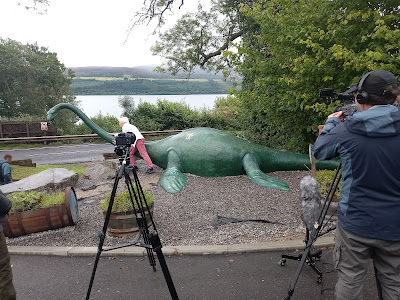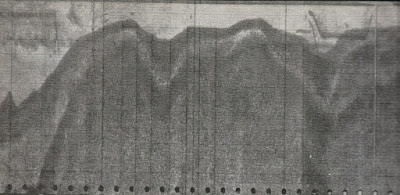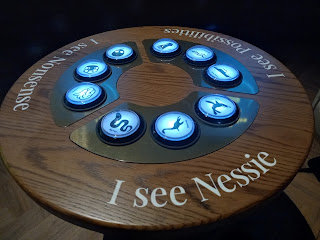I watched the latest Loch Ness Monster documentary which recently televised on the 22nd September. I believe this had previously shown on the new Paramount+ UK subscription channel a while back. That was originally shown as a three part series, but Channel 5 broadcast it as a single show lasting just over two hours, including adverts. I am not aware if anything was cut out from the originals. It was produced and directed by Stephen Finnigan for Two Rivers Media Limited.
I don't always review every documentary that is broadcast and looking back, I note I did not do the History's Greatest Mysteries episode from Sky History last June or the Zachary Quinto double header from January 2020. The last documentary I reviewed was also shown on Channel 5 back in March, so I wondered how this one differed from that as one does like to see a bit of variety in what is presented, although the basic facts of the mystery must needs be laid out for new viewers.
As I have said before, these documentaries are not made for the likes of long term watchers such as myself, they are aimed at the general public but there are some variations on a theme as producers try to put a different spin on the usual boilerplate formats lest increasingly informed audiences lose interest. So we have seen documentaries focused on Frank Searle, the recent eDNA project, Robert Rines, the major hoaxes or specific species candidates. In this case, there was an emphasis on the twelve year period from Tim Dinsdale's film to the Rines Flipper picture.
The players in this documentary known to me were Adrian Shine, Gary Campbell, Dick Raynor, Simon Dinsdale, Darren Naish, Willie Cameron, Malcolm Robinson, Tony Harmsworth and David Martin. As the documentary proceeded upon a timeline narration from 1933 onwards, various people would chip in with appropriate sound bytes as the documentary flipped between general narrator (Dougray Scott) and a given expert, depending on what was being discussed in that slot.
Not so familiar to me was a Stuart McHardy (Scottish Historian), Jenny Johnstone (Scottish Historian), Elsa Panciroli (Paleontologist) and Mara Menzies (Folklorist). These were not Loch Ness Monster experts but I suppose people looking from the outside in with some skill in related areas. Well, maybe, and others will be mentioned later.
Once upon a time in a far away land, there was a loch and in that loch was a monster. Or so some people supposed but others laughed and thought it foolish.
I think that fairytale like beginning sums up any documentary. It is natural to start a story at the beginning and for most that is the year 1933. So the various participants took us through the proverbial first sighting in water, first reporter, first sighting on land and first photograph. Now through all these narratives, the odd mistake will be made. I make them myself when I appear in such productions if one mis-speaks during an interview. One normally does not ask for a re-take if it is a minor sin of commission or omission.
I will come to the big sin of omission further down. But Aldie Mackay's sight of something black and glistening was presented as was the famous Spicer land sighting. Here we were pleasantly surprised to meet Mark Spicer, a grandson of George Spicer. I even got my first look at Mrs. Spicer in a photograph - though I still do not know her first name. Mark told us that his grandmother would tell them the tale of the monster and she wouldn't have told them if she didn't believe it to be true.
Alongside these was included the multiple eyewitness account from the Halfway House by the Alltsigh river on the 22nd September 1933. I initially wondered why this was included and then remembered my own write up on this account here and the statement that this was another first - the first sighting of a long neck. Well, I don't think it was, they were beaten by about 20 days, but it is actually a fascinating account as two others claimed to have seen a long neck at other parts of the loch the same day.
It was onto the first photograph taken by Hugh Gray and here was the big sin of omission. With all those experts to advise the production team, how on earth did they end up showing the terrible over-contrasted version of the photograph? When they could have used the Heron-Allen version instead?
The first version is poor quality, over-contrasted and retouched as was the fashion of newspaper editors in those days. The second is the superior version and has been available for use since the 1980s. I was going to send off a communication to the program's senior researcher asking that question, but why bother? However, in doing this, they missed a trick as it later transpired.
All this combined, as the program said, to light the blue touch paper. One speaker said people like to place their monster in dark places, such as peat-stained waters. That didn't quite explain the Loch Morar Monster which resides in clear waters. Nevertheless, in preparation for the later expose of the Surgeon's Photograph, we followed the adventures of Marmaduke Wetherell, who was described as the first person to come up and conduct a search and investigation of the loch.
I would normally agree with that but then concluded that the first person of note to do that was actually sea serpent expert, Lt. Cdr. Rupert T. Gould, who was up at the loch by November of that year. Wetherell arrived in mid-December. Be that as it may, the story of the fake hippo tracks ensued and we are told Wetherell was sacked from the Daily Mail investigation and left under a cloud with the apparent intent to give the Mail their monster photograph.
Once again, I am not sure Wetherell was actually sacked. He had conducted this investigation for a full month and then claimed he had seen a huge seal in the loch to close it all off with the explanation that this was what all the fuss was about. Actually, Wetherell's seal would clock in at nearly thirty feet and it was a sighting as convenient for the end of the expedition as the discovery of tracks was at the beginning. Like Alastair Boyd, co-author of the Surgeon's Photograph expose book, I think Wetherell cooked up this sighting. There was no seal in the loch at that time, certainly not one of those proportions.
That led to the Surgeon's Photograph of April 1934 and the oft-mentioned story of the investigation into how Wetherell and his associates had seemingly duped the Daily Mail. The other author of the expose book alongside Alastair Boyd was David Martin and he was interviewed about the Wilson picture. Not once was Alastair mentioned in the documentary. You would think he had nothing to do with the book, so I was a bit puzzled as to why he was not even credited with his part in this story.
Various other events from 1933 to 1934 were mentioned such as the Edward Mountain expedition and of note was what appeared to be a glimpse of the leader, Captain Fraser's, log book. Or was it? I wonder what dark corner that book is being held in. Then the documentary took a big leap of 24 years from 1934 to 1958. Had the Loch Ness Monster vacated the premises and gone off on holiday somewhere? No, the media generally lost interest to focus on the troubles in Europe and all that came from that.
The story resumes with the Peter MacNab photograph published in 1958, though it was taken in 1955. Some comments were made about the photograph suggesting they did not accept it but no expose story like the Surgeon's Photograph was forthcoming, because there are none. However, all seemed to be going well at this point as there was no concerted sceptical attack upon the stories or images as a whole. I began to think that the second half of the documentary was going to metamorphose into an attempted demolition job as various opinions on why these were all non-monsters would unfurl one by one.
But that didn't really happen.
So, the documentary entered the busy period of 1960 to 1972 as the Dinsdale film was taken and appeared on the BBC Panorama program rekindling interest in the monster and a series of expeditions throughout that decade. At this point, Simon Dinsdale entered the story as did some people from the Loch Ness Investigation Bureau. These were Dick Raynor, Alison Skelton and Peter Davies, who volunteered for service over those years. I do not recall seeing the latter two in television before, so that proved to be of additional interest as these people recounted their tales of monster hunting and also the human side of the story.
Alison was the wife of Clem Skelton, one of the important members of the LNIB whose camera skills helped set up the various camera watches. He had altogether been a Spitfire fighter pilot, high altitude reconnaissance photographer, actor, novelist and monster hunter.
I was interested to hear her give an account of an encounter that Clem may have had with the creature back in those days. She said he was rowing across the loch about the time of dusk when something came up beside him, making bubbling sounds and was larger than his boat. He did not investigate and rowed as fast as he could to shore. I guess I would have done the same thing rather than think of the photo-op of the century.
Then Dick Raynor told us about his time there and the film he shot in 1967 of an object making its way on the loch leaving a wake behind it. The LNIB regarded this as an important piece of evidence and submitted it to JARIC for photographic analysis, concluding the object was perhaps seven feet long and travelling at 5mph. The story of Dan Taylor and his yellow submarine were told before moving onto the arrival of Robert Rines and the Academy of Applied Science from America.
Dick commented that this felt like NASA was getting involved in the hunt and it wouldn't be long before they got results. On and after the night of August 8th 1972, i would have certainly felt that way. Dick Raynor and Peter Davies recounted their experiences on the night the famous "flipper" photograph was taken. What came out of that leads us into the section of the documentary on Robert Rines.
This took us into 1975 and those controversial head and body photos, the article in the prestigious Nature magazine naming the Loch Ness Monster, the postponed meeting with scientists and the press conference at the House of Commons. A leap of 12 years then takes us to Operation Deepscan and its inconclusive results.
So the program switched to two investigators, Rikki Razdan and Alan Kielar, who discovered the 1972 flipper photograph was a claimed enhanced image which bore little resemblance to what the Jet Propulsion Laboratories produced and they were right. It had been retouched by parties unknown who to this day have not confessed to the deed. They also visited Winifred Cary to find that Robert Rines had used her so called psychic dowsing skills to pinpoint where to place their underwater cameras. To this day, it is not clear to me what Rines' reply to this was?
One thing seems certain, as a lawyer Rines never sued them over these claims. We then switched to a fuller exposition of the Surgeon's Photograph hoax, but there was no new information added to that particular story. After some more psychological words about people wanting the monster to exist, we ended up with the recent eDNA survey results and no reptiles but lots of eels.
That eel reference left some speculating that some of what had been previously spoken about could support a giant eel theory. They picked the so-called eel-like nature of what the women at the Halfway House in 1933 saw and the "snake-like" characteristics of what Hugh Gray photographed. Well, at least they admitted these people saw a large unknown creature but there is nothing eel-like in what was reported by those women or anything snake like in Gray's photograph. But, as stated earlier, if they had used the superior Gray image and dug around a bit more, they would have had an eel-like head to bolster their case.
After some more lightweight psychology about the monster being ingrained in the culture, a mystery we cannot let go and the more we want to believe, the more it stays in our mind, the documentary ended. After all that, I wondered if a change in direction for this genre of documentary was required? How about a documentary that focusses on land sightings, or one on events before 1933 or one that tracks a team of monster hunters (like the bigfoot programs) and so on? Well, the last one may be in the offing, but I suspect even the general viewing public may be getting tired with the same old format.
Maybe that is more down to the lack of imagination of the broadcasting organisations to whom these documentaries are sold to. Either way, the vast majority of stories on the monster remain untouched by these people while they play it safe with a tight subset of the genre which is rarely updated.
Comments can be made at the Loch Ness Mystery Blog Facebook group.
The author can also be contacted at lochnesskelpie@gmail.com



































